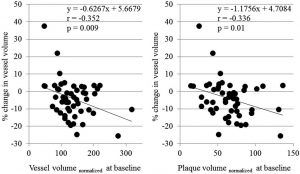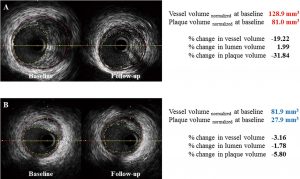 Effect of Reverse Vessel Remodeling on Regression of Coronary Atherosclerosis in Patients Treated With Aggressive Lipid- and Blood Pressure-Lowering Therapy - Insight From MILLION Study
Effect of Reverse Vessel Remodeling on Regression of Coronary Atherosclerosis in Patients Treated With Aggressive Lipid- and Blood Pressure-Lowering Therapy - Insight From MILLION Study
Gamou T, Sakata K, Tada H, Konno T, Hayashi K, Ino H, Yamagishi M, Kawashiri MA; MILLION Study Group.
Circ J. 2017 May 17. ![]()
Impact Factor (2016): 4.12
BACKGROUND:
The MILLION study, a prospective randomized multicenter study, revealed that lipid and blood pressure (BP)-lowering therapy resulted in regression of coronary plaque as determined by intravascular ultrasound (IVUS). In the present study we performed additional analysis to investigate the associated factors with regression of coronary plaque.
METHODS AND RESULTS:
Methods and Results:We investigated serial 3D IVUS images from 68 patients in the MILLION study. Standard IVUS parameters were assessed at both baseline and follow-up (18-24 months). Volumetric data were standardized by length as normalized volume. In patients with plaque regression (n=52), plaque volumenormalizedsignificantly decreased from 64.8 to 55.8 mm3(P<0.0001) and vessel volumenormalizedsignificantly decreased from 135.0 to 127.5 mm3(P=0.0008).
There was no difference in lumen volumenormalizedfrom 70.1 to 71.8 mm3(P=0.27). There were no correlations between % changes in vessel volume and cholesterol or BP. On the other hand, negative correlations between % change in vessel volume and vessel volumenormalizedat baseline (r=-0.352, P=0.009) or plaque volumenormalizedat baseline (r=-0.336, P=0.01) were observed.
CONCLUSIONS:
The current data demonstrated that in patients with plaque regression treated by aggressive lipid and BP-lowering therapy, the plaque regression was derived from reverse vessel remodeling determined by vessel volume and plaque burden at baseline irrespective of decreases in lipids and BP.
















